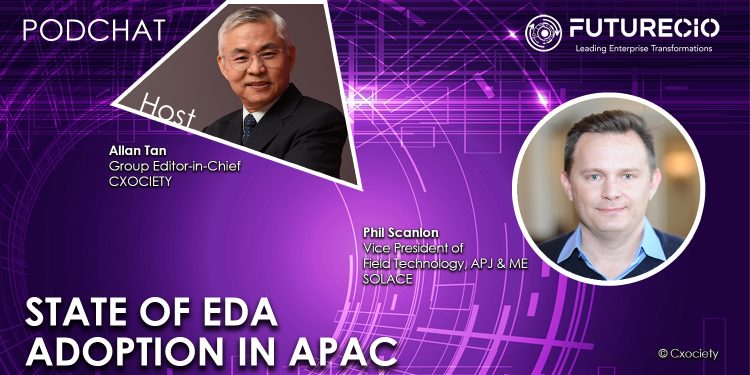Gartner defines an event-driven architecture (EDA) as a design paradigm in which a software component executes in response to receiving one or more event notifications. EDA is more loosely coupled than the client/server paradigm because the component that sends the notification doesn’t know the identity of the receiving components at the time of compiling.
Phil Scanlon, vice president of field technology, APJ & ME with Solace, sees EDA as a different approach to looking at problems.
“For instance, tapping a card to make a payment or a truck leaving a warehouse with some goods. Traditionally, these events have been buried inside enterprise applications, or they take a while to surface to the rest of the enterprise with batch processing. In comparison, EDA enables enterprises to react to events that are happening in their business across the value chain, and capitalize on the opportunities, all in real-time,” he elaborated.
Adoption of EDA in Asia-Pacific remains uneven with markets like Hong Kong and Australia in line with more developed markets like the US. Yet, even advanced markets like Korea and Japan have yet to accept the design paradigm.
Adoption trends
Forrester senior analyst David Mooter commented that EDA is crossing the chasm of tech adoption.
Solace commissioned Coleman Parkes to conduct a global survey which revealed that:
- 85% of respondents recognize the critical business value in adopting EDA
- Adoption is still 'early days' as only 13% claim to have achieved full EDA maturity
- The IT department is bought in, but more work needs to be done with business leadership
Scanlon observed that while EDA has become a necessity, adoption varies relative to the maturity of markets. “The interesting thing about EDA is that it is not a slow thing that takes a while to emerge. Until a few years ago, it wasn’t widely known. Suddenly, it was on everyone’s agenda. So I expect that the pace in some markets (in Asia) will also accelerate,” he noted.
Obstacles to adoption
Reflecting on the survey, Scanlon noted that 78% of respondents in APAC cited the lack of adequate technology as a key roadblock.
He reminds us that EDA is not just a single technology but an approach that requires different changes in various parts of the organization.
“What we’re focused on at Solace is the infrastructure and powering real-time information across all applications. We’ll get information where it needs to be, but organizations still need to think about how to use it. So there needs to be understanding of what are the right tools and engaging with the vendors that are able to help,” he elaborated.
“The other challenge is the same as with any new technology: finding people, partners and talent with the right skill sets and education so that people really understand the benefits of the technology and how it aligns with their business priorities.”
Phil Scanlon
Awareness of EDA
Scanlon admits that within the IT hierarchy, lower levels in the IT totem pole are more familiar with the technology. He acknowledged that EDA has entered the CIO agenda in recent years although this remains low at only 50% of CIO respondents. At the business executive level, however, recognition remains low at about 37%.
“We are seeing more conversations about EDA being elevated to a higher level in the last few years. The number of senior leaders, both on the IT and business side, that are pointing to real-time data as an enabler for their objectives is growing,” he commented.
Investment strategy
Scanlon suggested looking at EDA for the long-term value that the business would get and start investing.
“There is a bit of investment upfront, but with the right approaches it will unlock future value by the second or third project,” he advised. “It's hard to understand that before you've even started so talking to people that have been through some of these journeys can be valuable.”
Advise moving forward
EDA solves problems around real-time interaction, hybrid cloud information, and where the same information exists in many parts of the organization and is being used in many places.
“The changing nature of real-time means that it is difficult to define the opportunities next year. However, putting in the right platform enables organizations to decouple things. When events are decoupled from the applications, then organizations react to events without having to change their applications. We see organizations going for this approach to set up quicker,” concluded Scanlon.
Click on the PodChats player to hear Scanlon go into the details of a discussion on event-driven architectures and how your organization can derive business and operational value from the technology.
- What is your definition of EDA?
- What is the state of EDA adoption in Asia Pacific compared to the rest of the world?
- For decades enterprises have relied on information systems such as ERP to give them up-to-date data about the business. Do they understand the difference between what applications like ERP bring compared to EDA?
- For businesses that have not reached a state of EDA maturity, what are some of the obstacles that lie in their way?
- Which are the business roles that appreciate EDA the most and which needs more education?
- Any misconceptions particularly business leaders that become a barrier to EDA acceptance?
- Who should lead EDA adoption across the enterprise?
- How do APAC organisations balance the costs and benefits of EDA?
- How prepared are organisations to support real-time data distribution?
- Given that EDA is an acceleration of data in the decision-making process, how does IT ensure security policies and frameworks remain in place even with EDA in place?
- Coming into 2022, what do you see will further drive EDA adoption in APAC?





